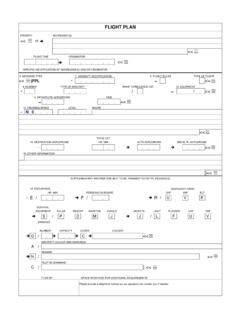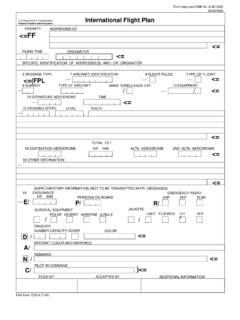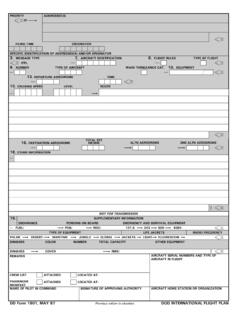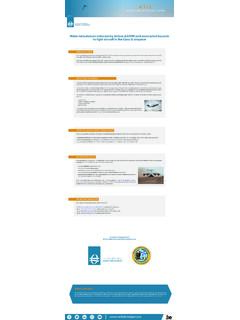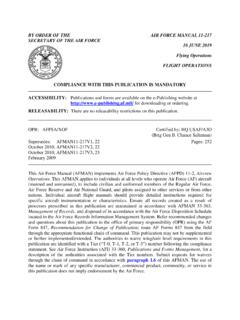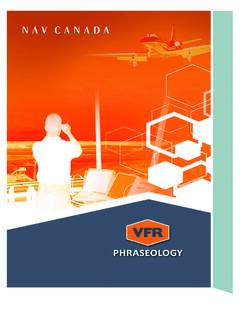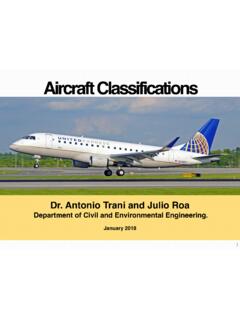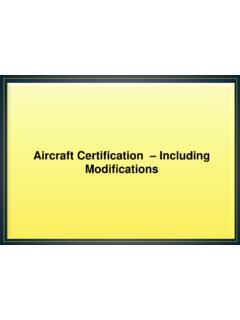Transcription of FAA Order JO 7360.1E Aircraft Type Designators
1 :10/10/2019 SUBJ:AircraftTypeDesignatorsThisdirectiv eprovidesaircrafttypedesignators(standar dabbreviationsforaircraft) ,aircraftoperators, , )evezActingDirector,AirTrafficProcedures AirTrafficOrganizationDate:TableofConten tsChapter1. Contentsof (WTC) (CWT) (SRS) (LARSO)Groups6 Chapter3. JO Chapter 1 1 Chapter 1. General Information 1-1. Purpose of This Order . This Order provides standard abbreviations ( Aircraft type Designators ) for the most common Aircraft that are provided with air traffic services (ATS). This Order also provides additional reference information used by ATS. 1-2. Audience. This Order applies to all Air Traffic Organization (ATO) personnel and anyone using ATO directives. 1-3. Where to Find This Order . This Order is available on the MYFAA employee Web site at and 1-4. Cancellation. This Order cancels FAA Order JO , Aircraft Type Designators , on the effective date of this Order .
2 1-5. Distribution. This Order is distributed to selected offices in Washington headquarters, service area offices, regional offices, the William J. Hughes Technical Center, the Mike Monroney Aeronautical Center, all air traffic field facilities, international aviation field offices, and interested aviation public. 10/10/2019 JO Chapter 2 2 Chapter 2. Contents of This Order 2-1. Aircraft Type Designators . An Aircraft type designator is an abbreviated form of an Aircraft type. This designator is used in air traffic service automation systems that exchange data. The Aircraft type designator is primarily used in flight plans and air traffic service messages but may be used in other matters when needed. Appendix A of this Order contains an alphabetized list of Aircraft type Designators . 2-2. How Designators are Formulated.
3 The International Civil Aviation Organization (ICAO) has the role of creating standard Aircraft type Designators for Aircraft that commonly request air traffic service. ICAO assigns an Aircraft type designator using the following principles: a. Only one designator will be assigned per Aircraft type. b. A designator will be derived from the manufacturer s model number or name, or from a common military type. c. The designator will not be longer than four characters and will generally begin with a letter. d. An assigned designator will not be changed for: license-built Aircraft , when an Aircraft model is sold to or manufactured by another company, when the manufacturer s name changes, or when the Aircraft type is derived or converted from another type. e. A different designator for an alternate or subtype version of the Aircraft will only be allocated when there is a significant difference in performance for ATS or no shared designator can be assigned.
4 F. Homebuilt, amateur-built, or kit plane Aircraft that exist in operationally significant numbers will be assigned a designator ; however, these Aircraft will only be listed under the original designer or under the manufacturer that produces or produced the Aircraft type in series. g. In general, an Aircraft type designator will be assigned to all Aircraft heavier than micro-/ultra-light. For the purpose of ICAO Document 8643: (1) Micro-/ultra-light are those Aircraft types with a maximum certified take-off weight of 1,000 pounds or less and a stall speed not greater than 35 knots. (2) Micro-/ultra-light helicopters and gyrocopters are those helicopters or gyrocopters with a maximum certified take-off weight of 1,000 pounds or less. h. Roman numerals used as part of Aircraft model names or numbers will be replaced by Arabic numerals.
5 REFERENCE ICAO DOC 8643, Aircraft Type Designators NOTE 1 An asterisk (*) next to an Aircraft type designator denotes a single-piloted military turbojet Aircraft . REFERENCE P/CG Term Single-Piloted Aircraft NOTE 2 For the purpose of Class B Service Area separation, the Aircraft type designator of Aircraft weighing 19,000 pounds or less is underlined. For example, PANT, HAWK, UH1Y, etc. REFERENCE FAA Order JO , Para 7-9-4, Separation. 10/10/2019 JO Chapter 2 3 2-3. Special Designators . Use these Designators for the following Aircraft : a. BALL Balloon. b. GLID Glider/sailplane. c. GYRO Micro-/ultra-light gyrocopter. d. PARA Powered parachute/Paraplane. e. SHIP Airship. f. UHEL Micro-/ ultra-light helicopter. g. ULAC Micro-/ultra-light Aircraft . h. ZZZZ Aircraft type not yet assigned a designator , with a description of the type in Item 18 (Other Information) of the ICAO flight plan or Remarks of a NAS flight plan.
6 2-4. Aircraft Manufacturers. The manufacturer of an Aircraft is shown in capital letters, such as FAIRCHILD. A number in parentheses, for example (2), denotes a manufacturer using the same name as another manufacturer. See Appendix B for an alphabetical list of Aircraft by manufacturer. Appendix D of this Order contains an alphabetized list of Aircraft manufacturers and country of origin. 2-5. Aircraft Models. Model names are listed, including military Designators . Appendix C of this Order contains an alphabetized list of Aircraft model names/numbers. 2-6. Aircraft Class. The class is part of the description used to distinguish an Aircraft type. The following Aircraft classes are used: a. Fixed-wing. NOTE Amphibians are denoted as @Fixed-wing and seaplanes are denoted as $Fixed-wing. b. Gyrocopter. c. Helicopter.
7 D. Tiltrotor. 2-7. Aircraft Engine Number and Type. The number of engines and engine types are included as part of the Aircraft description. The following are abbreviations for engine types : a. E Electric. b. P Piston. c. T Turboprop/Turboshaft. d. J Jet. e. R Rocket. NOTE A C is used to indicate a fixed-wing Aircraft having two engines coupled to drive a single propeller system. 10/10/2019 JO Chapter 2 4 2-8. Aircraft Weight Class. a. J Super. AIRBUS A-380-800 (A388) and ANTONOV An-225 (A225). b. H Heavy. Aircraft capable of takeoff weights of 300,000 pounds or more whether or not they are operating at this weight during a particular phase of flight. c. L Large. Aircraft of more than 41,000 pounds, maximum certificated takeoff weight, up to but not including 300,000 pounds. d. S Small.
8 Aircraft of 41,000 pounds or less maximum certificated takeoff weight. NOTE 1 A + denotes an Aircraft weighing between 12,500 pounds and 41,000 pounds. For Class B airspace rules, these Aircraft are large, turbine-engine-powered Aircraft . NOTE 2 NOWGT (no weight) means a Weight Class has not been determined for wake turbulence separation. REFERENCE P/CG Term Aircraft Classes 2-9. wake turbulence Category (WTC). In an ICAO flight plan, the WTC indicator follows the Aircraft type designator in Item 9 (Number and Type of Aircraft and wake turbulence Category), for example, A345/H, GAZL/L, E737/M, and is based on the maximum certificated take-off weight, as follows: a. Heavy (H) Aircraft types of 300,000 pounds or more; b. Medium (M) Aircraft types less than 300,000 pounds and more than 15,500 pounds; c.
9 Light (L) Aircraft types of 15,500 pounds or less. NOTE 1. Where variants of an Aircraft type fall into different ICAO wake turbulence categories, both categories are listed, such as Light/Medium or Medium/Heavy. In these cases, it is the responsibility of the pilot or operator to enter the appropriate single character WTC indicator in Item 9 of the ICAO flight plan. 2. Special Designators , such as GLID, UHEL, ZZZZ, etc., require a WTC in an ICAO flight plan using the criteria above. In these cases, it is the responsibility of the pilot or operator to enter the appropriate single character WTC indicator in Item 9 of the ICAO flight plan. REFERENCE ICAO DOC 4444 Procedures Air Navigation Service Air Traffic Management, Para wake turbulence Categories 2-10. RECAT wake Category. For the purposes of wake turbulence separation minima, Aircraft are categorized as Category A through Category F.
10 Each Aircraft is assigned a category based on wingspan and maximum takeoff weight (MTOW). a. Category A Aircraft capable of MTOW of 300,000 pounds or more and a wingspan greater than 245 feet. b. Category B Aircraft capable of MTOW of 300,000 pounds or more and a wingspan greater than 175 feet and less than or equal to 245 feet. c. Category C Aircraft capable of a MTOW of 300,000 pounds or more and a wingspan greater than 125 feet and less than or equal to 175 feet. 10/10/2019 JO Chapter 2 5 d. Category D (1) Aircraft capable of a MTOW less than 300,000 pounds and a wingspan greater than 125 feet and less than or equal to 175 feet; or (2) Aircraft capable of a MTOW greater than 41,000 pounds with a wingspan greater than 90 feet and less than or equal to 125 feet. e. Category E Aircraft capable of a MTOW greater than 41,000 pounds with a wingspan greater than 65 feet and less than or equal to 90 feet.










